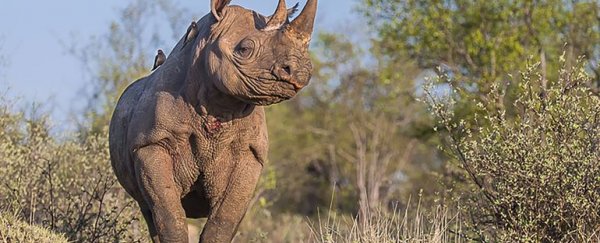Just over 100 years ago, there were more than one million black rhinos roaming the African savannah. But the harsh realities of poaching and habitat loss have left only 5,055 of the animals on the planet.
Now, thanks to science fans around the world, a team of researchers has managed to crowdfund the first part of a project that aims to sequence the critically endangered species' genome, and use the information within it to help keep the species alive.
This isn't the first attempt to save black rhinos. Out of the eight original subspecies, three have already been poached to extinction. In the hopes of protecting the remaining individuals, scientists have used armed guards and drones to keep an eye on the rhinos, and researchers in the US have even managed to bioengineer a synthetic rhino horn that they hope will relieve poaching pressure.
But this new project takes a different approach, by finding out more about how the species has evolved over millions of years, and how we can help it to survive now.
"With the genome of the black rhino we will be able to answer the following questions," the team, which is led by University of Washington biologist Charles 'Chuck' Murry, wrote on their Experiment crowdfunding page. "How did the black rhino evolve into a subspecies? What loci in the black rhino genome show a susceptibility to disease?"
The team managed to raise US$17,000 for the first stage of their project - which is US$2,000 above their goal - and will use that to sequence the genome of a black rhino called Ntombi (pictured above).
Once they have Ntombi's genetic sequence, they'll align it to the existing southern white rhino genome to find out where the two species diverge. The entire project will be open-access, and the team aims to publish the results in a peer-reviewed journal. They also have some slightly bolder goals beyond conservation, with the team hoping that the genetic sequencing could help them to bring some of the extinct subspecies back to life.
"We intend to use this project as a catalyst to sequence all subspecies of black rhino and understand the genetic divergence within and between rhino species," the team explains. "This will be a foundation that future researcher can utilise and could possibly help bring the three currently extinct black rhinoceros subspecies back into existence."
This isn't the only ambitious research project to seek out funding from the public, rather than the government or traditional funding bodies. Earlier this week, a scientist spoke out about crowd-funding her own PhD project, which involved sequencing the genome of an invasive species of mussel in the Amazon River, and admitted that she believes the public needs to play a larger role in research in the future.
"The decisions we make in the next few decades, individually and as a group, will define the fate of this planet and of humanity," wrote Brazilian scientist Marcela Uliano da Silva. "The more of us are engaged with science, the more we can make informed decisions about how to live daily life - what to consume, how to vote and, yes, whose research to support."
Major pats on the back to all those who decided to get behind the black rhino project. Here's hoping scientists can use the information they learn to keep these beautiful animals on the planet. Now if only we could find out a way to save the last male northern white rhino.
Find out more about the black rhino genome project in the Experiment crowdfunding video:
